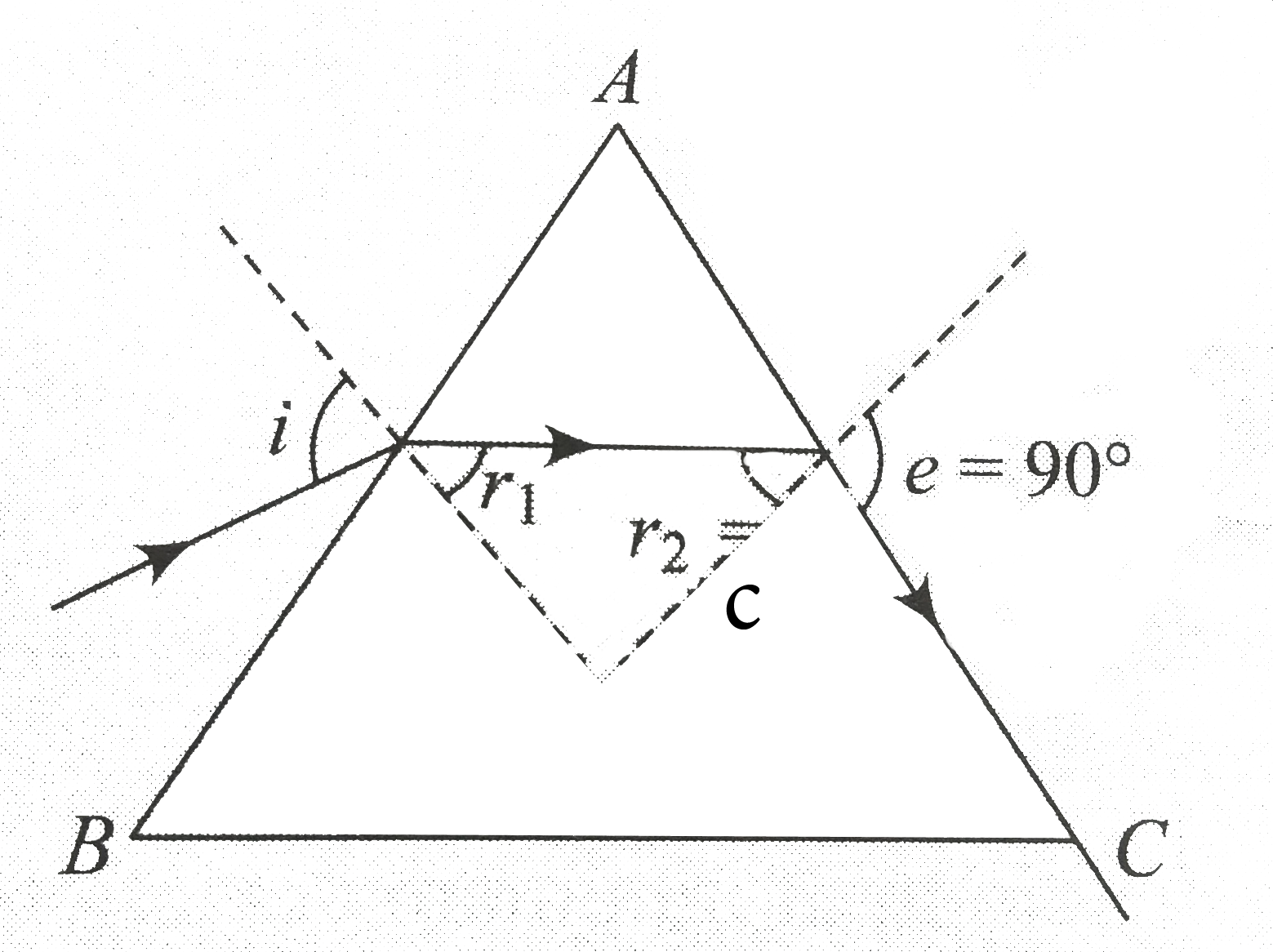A right angled prism is to be made by selecting a proper material and the angles A and B (B≤A),asshown∈figure.Itisdesiredtˆarayoflight∈cntonthefaceABemer≥sparal≤l→the∈cntdirectionaftertwo∫ernalref≤ctions.<br><imga≤ocr_imageload∈g=lazysrc=https://d10lpgp6xz60nq.cloudfront.net/physics_images/DCP_V05_C31_S01_034_Q01.pngwh=80%mx-autosty≤=background:white;><br>(a)Wˆshod––betheminiμmretive∈dexnforthis→bepossib≤?<br>(b)Forn=5/3isitpossib≤→aχevethiswiththe∠Bequal→30 degrees?

a. Consider the ray incident normally oN/AB ure. The asngle of reflectin at the surface AC is theta. It is clear from the ure that the angle of incidence ast th secon surface CB is 90∘−θ. The emergent ray will be paralel to the incidnet ray after two total inteN/Al refelection.The critical angle θc should be less than theta as well as 90∘−θ. Thus θc should be smaller than or equal to the smaler of θand90∘−θ,i.e,
theta_clemin(theta,90^@-theta)<br>Asmin(θ,90∘−θ)≤45∘,θc≤5∘
or sinθc≤1√2or1μ≤1√2
or μ≥1√2
Thus the refrctive index of the material of hte prism should be greater than or equal to √2. In this case teh gien ray can undrgo tow inteN/Al reflections for a suitable theta.
b. For μ=53 the critical angle θc is
sin−1(35)=37∘
As the ure suggests we consider the lightincident normally on the face AB. The angle of incidence θ on the surface AC is equal to θ=60∘. As this is larger than the cirtical angle 37∘, total internla reflection takes place here. The angle of incident at the surface CB is 90∘−θ=30∘. As this is less than teh critial ange, total interN/Al reflection does not take place at this surface.
Similar Questions
A right angled prism is to be made by selecting a proper material and the angles A and B (B≤A),asshown∈figure.Itisdesiredtˆarayoflight∈cntonthefaceABemer≥sparal≤l→the∈cntdirectionaftertwo∫ernalref≤ctions.<br><imga≤ocr_imageload∈g=lazysrc=https://d10lpgp6xz60nq.cloudfront.net/physics_images/DCP_V05_C31_S01_034_Q01.pngwh=80%mx-autosty≤=background:white;><br>(a)Wˆshod––betheminiμmretive∈dexnforthis→bepossib≤?<br>(b)Forn=5/3isitpossib≤→aχevethiswiththe∠Bequal→30 degrees?
View SolutionA right angled prism is to be made by selecting a proper material and the angles A and B (B≤A),asshown∈figure.Itisdesiredtˆarayoflight∈cntonthefaceABemer≥sparal≤l→the∈cntdirectionaftertwo∫ernalref≤ctions.<br><imga≤ocr_imageload∈g=lazysrc=https://d10lpgp6xz60nq.cloudfront.net/physics_images/DCP_V05_C31_S01_034_Q01.pngwh=80%mx-autosty≤=background:white;><br>(a)Wˆshod––betheminiμmretive∈dexnforthis→bepossib≤?<br>(b)Forn=5/3isitpossib≤→aχevethiswiththe∠Bequal→30 degrees?
View Solution
Knowledge Check
- Question 1 - Select One
What should be the minimum value of refractive index of a prism of refractive angle A, so that there is no emergent ray irrespective of angle of incidence?
AsinA2BcosA2CcosecA2DsecA2 - Question 2 - Select One
The refracting angle of a prism is A, and refractive index of the material of the prism is cot(A)2. The angle of minimum deviation is
A180∘−3AB180∘ - 2AC90∘ - AD180∘+2A - Question 3 - Select One
The refracting angle of a prism is A and refractive index of the material of the prism is cos(A/2). The angle of minimum deviation is
A180∘−3AB180∘−2AC90∘−AD180∘+2A
What should be the minimum value of refractive index of a prism, refracting angle A, so that there is no emergent ray irrespective of the angle of incidence?
 View Solution
View SolutionThe angle of minimum deviation caused by a prism is equal to the angle of the prism. What are the possible values of refractive index of the material of the prism?
View SolutionThe refracting angle of a prism is A, and refractive index of the material of the prism is cot (A/2). the angel of minimum deviation is
View SolutionFor the angle of minimum deviation of a prism to be equal to its refracting angle, the prism must be made of a material whose refractive index
View SolutionFor the angle of minimum deviation of a prism to be equal to its refracting angle, the prism must be made of a material whose refractive index
View Solution

